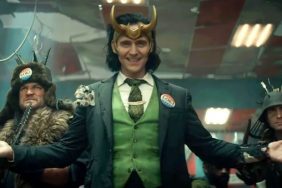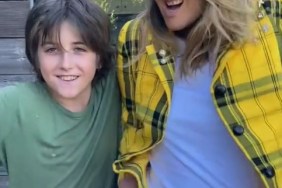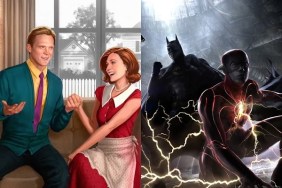In the early 2000s, writer/director Neill Blomkamp was making ambitious science-fiction short films which would one day be turned into feature film. Now, over a decade later, with three big budget studio films under his belt and an Oscar nomination for writing a sci-fi action movie (a very rare feat), he’s doing it all over again.
Neill Blomkamp has founded Oats Studios, an ambitious new company which produces sci-fi/horror short films – for free – with the intention of turning the most popular installments into features. The output of Oats Studios looks at a glance like films made by mad scientists, and we like them that way.
Neill Blomkamp has directed the most expensive Oats Studios shorts so far. There is Rakka, a gritty war film set in a future where Earth has been invaded by lizard-like aliens, and Firebase, a high-concept Vietnam War film set in a virtual reality where the rules are sometimes broken. And today Oats Studios releases Blomkamp’s third short film, Zygote, which stars Dakota Fanning as a young woman in a futuristic mining operation, who is told that she was only born to die for her superiors, and suddenly has to fight for her own life against a monster comprised of a freakish number of spare body parts.
Oats Studios is an interesting experiment, founded by an interesting filmmaker. So I got Neill Blomkamp on the phone yesterday to talk about his mission statement, how Oats Studios intends to sustain itself, how YOU can help decide which shorts get made into feature films, and what makes Zygote so danged weird.
Watch the short below, and read the interview after. Some SPOILERS lie ahead.
Crave: I am so excited by the all possibilities involved in Oats Studios. It feels like the short film, although it isn’t going anywhere, isn’t getting enough attention. This project, this studio you’ve created, at least it has opportunity to change that. Is that part of the mission statement?
Neill Blomkamp: I think the mission statement is really for us to try to be as free and creative open to making whatever we want to make. So the byproduct of that is, we can make more pieces if they are shorter, and show the audience more worlds, or avenues that we can go down. Instead of one piece that’s 80 minutes long, we make four that are 20 minutes long. It’s sort of like the shorter film allocation is a byproduct of financial limitation. I wish that I had a two-hour film for each of these, but we don’t have the [finances].
So yeah, it’s a hard one to answer. If you look at things like God, the God short we did, or the weird, totally insane cooking show stuff, those are meant to be the length that they are. It’s hard to expand those out further. And those are designed to be shorter in nature. But the bigger ones are meant to eventually evolve into longer formats.
I normally wouldn’t ask such a technical, behind the scenes question, but these shorts… you say it’s cheaper to do them this way but they look really expensive. How expensive is a typical short, at least on the scale that you are making them at Oats?
Any of the 20-minute ones are several million dollars, so they’re not cheap. They’re probably cheaper and more efficient than how you would normally do them, in any normal production sense, but they are still expensive.

“Firebase,” Oats Studios
So is the business model, from that perspective, since you’re spending millions of dollars on these shorts, to turn them into features? Or is there another endgame? Could these be released as an anthology?
We never really thought that the shorts themselves would generate revenue in any way. It was always more a case of… First of all, when we first got into it, it was like, okay, would people buy this kind of material, where the beginning and the middle and the end, a three-act film structure isn’t really present as much? Will they feel ripped off? Can you even sell something like this? And we felt like a smarter move would just be to release everything for free, so the audience knew what to expect, and then if we want to attempt to charge for Volume 2 we could because you could make the argument that the audience knew what they were getting involved in, because Volume 1 was out for free.
But the more we thought about that the more that also didn’t make sense, and I think, personally, to me, the best model of the whole thing would be to continuously release volumes online, for free, for as long as we can. Hopefully just forever. And you pick your favorite pieces, the pieces that the audience is really responding to. So in a sense that’s where the [is] audience kind of picking.
But if you release five pieces and two are standout hits, then we inside the company could pick our favorite of those two and make a traditional film out of that, and the proceeds of that film would then finance Volume 2 and Volume 3. And you could do the same thing again with Volume 2 and Volume 3. Put those out for free, see which ones work, and then make a traditional, sellable piece out of whatever your favorite piece is.
So for me, from my perspective, that gives me the ability to always be in this creative environment of constantly coming up with ideas and executing them, and seeing what works and what doesn’t work, and then getting ready to scale up to a feature film for something that I feel really invested in, and something that I know the audience is behind. That has become what I think we’re going to do.

“Rakka,” Oats Studios
How do you know that the audience is behind it? Are you only looking at the number of views it’s getting on YouTube? Is it comments, social media engagements? If people have a favorite, how can they help?
Yeah, so that’s a really interesting question. I don’t think that we exactly know the answer to that because it is difficult to actually get to the bottom of all the incoming data. But you know, I think if you take every possible thing that you can find online – whether it’s comments, whether it’s view counts, whether it’s how our DLC downloads on Steam are going – [if] you just take all of the data and comb through it, you can come to an analytical end result that like, this one seems to be the best performing, and the audience seems to be responding to this the most. But you’re right though, it’s not easy.
So you’re coming up with new ideas, and you’ve already released some. You’ve already released Rakka and Firebase and now Zygote. How many of those were ideas you had before Oats Studios, and which of them were ideas you came up with “because” of Oats Studios?
Well, Rakka was older than the studio, but only 50% of it. Because Tom Sweterlisch, who wrote Rakka with me, brought a whole bunch of elements that I’d never thought of, and kind of merged them with this “alien invasion as a war film” idea. So that one is sort of a mixture, before and after. And I don’t know when Tom came up with those ideas. It could have been before Oats was formed.
Firebase was sort of a mixture of that, in sentiment. The idea of living in a virtual simulation, and having a character that had control over physics and thermodynamics, that idea was older than Oats but the Vietnam War setting and some of the stuff that Tom introduced – like the idea of Brackin being pulled into an alternate history of the United States – that was since Oats has been created.
And Zygote was entirely since Oats was created. Like, about a year-and-a-half ago, I think, I came up with the idea of these creature that was made up of stitched together body parts, and the building was… we were up and running at that point. So that was has been since we’ve been here.

“Zygote,” Oats Studios
I was going to ask, actually: Zygote does have a very cool-looking monster, and I was curious if the story emerged from the monster or vice-versa. I guess the monster came first. How did you build a narrative on top of this visual concept?
Well, usually what happens, at least for me, is the ideas are from a few different places and then they start to coalesce into something. So I had the idea for Barkley, who Dakota [Fanning] plays, as this synthetic human that’s been lied to, who is actually a human, and has acted like… she’s been treated as slave labor her entire life. I have that character in the setting of a mine, and then separate from it, this flight that I was on between Vancouver and Toronto, where I came up with the notion of this weird monster. And then those two independent ideas kind of merged into one idea. So I guess, to some degree, the monster did create some of the story but not all of the elements.
It’s interesting when you combine those two elements, because if she is an exploited worker, and the monster in the movie literally all the workers combined to strike back against the company, it kind of turns the creature into a metaphor for unions, doesn’t it?
[Laughs.] I haven’t heard anybody say that before. That’s pretty cool, though. Yeah, I like that. That’s kind of a deep, analytical point of view on the film, but I do like that. For me it was much based on trying to create something that was disgusting and terrifying, and had some sort of primal, Freudian gross-out factor to it, and I thought the idea of stitched together limbs did that.
On a deeper psychological level, I would say the fact that she is told that she’s a synthetic human, that there’s a heavy emphasis put on non-biological humans being treated worse, and the monster rejecting synthetic humans and opting only for biological humans that it cuts up and continues to absorb… that there’s some deeper psychological thing going on there about what it means to be human, and whether your body is the thing that makes you human. But no, the whole “union” approach is hilarious. I’ve not heard that before. I like that.
The idea of body horror, and the idea of your body being your own, it’s interesting because the film shifts once you find out Dakota Fanning’s character was born as a human. Because as it starts she’s a character who has to overcome her social station, in order to even fight for her own existence, and then she becomes someone who should never have become part of that station to in the first place.
Right.

“Zygote,” Oats Studios
Is that the sort of thing you’d want to play with more in an extended, feature-length version of Zygote?
Yeah. Yeah, for sure. Dakota’s character is kind of the lynchpin that I would build the framework of a feature film around, and I was completely aware of that when I wrote it with Terri [Tatchell] and Tom, and I was aware of it when I filmed it with Dakota. I mean, it’s just really interesting. I love the idea that she’s in her early twenties and she’s been lied to since she was literally a toddler.
So going back within the story, and getting to the point that this short film takes place, or going forward in the story from the end of this film, and we start the next one, both are really interesting to me, and kind of identify exactly what Oats is meant to do. Which is to show a very clear world of a particular science-fiction/horror setting. The result of the end of the film being made, for me, is that I enjoyed it. I like the result of it. I would kind of like to play with it more, and now I’m going to see if the audience feels the same way.
What’s interesting to me about Zygote, compared to Rakka and Firebase, is that Rakka and Firebase feel like condensed, larger narratives and Zygote feels like you had the full script for it and plucked out a chunk around the second and third act.
Yeah. That’s exactly correct, and it’s a complete conscious choice to do that. The conundrum that Oats poses is, if you have 20 minutes to show the audience a particular world that you feel like you want to make other films in, and you want to see if the audience feels the same way that you do, how do you display that world? What is the most effective way to bring an audience into the place that you want to take them, and let them live and breathe that place?
Option one is you can show something grander and bigger than any individual story, and almost go down this road that feels like documentary in some sense, where you’re kind of like, “This is rules of the world, this is what it’s like.” You’ll get hammered for too much exposition if you do that, but that’s life in the big city.
The second option is to give them a much smaller story that feels exactly like you just snipped 20 pages out of a larger screenplay, and let the choices that the characters are making inform the audience. At least give them a glimpse into something beyond what they are being shown. And both approaches are equally interesting.
Firebase is somewhere between the two. Rakka is extremely one direction, Zygote is extremely linear, and Firebase straddles the fence. It’s kind of neither of them. And that’s exactly what Oats should be. Which is the most interesting way? So yeah, it is 20 pages cut out of a bigger story and it’s a killer short.

“Firebase,” Oats Studios
It’s been interesting watching your career because you’ve been attached to other properties, existing franchises, a couple of times. But you keep coming back to making your own material and telling your own stories.
Right.
I’m curious what the experience of developing films like Halo and your Alien sequel has taught you, and how that informs your work at Oats?
Well, I mean Halo was a godsend because it introduced me to Peter Jackson and Fran Walsh, and they pretty much allowed me to have a career, essentially, because they made District 9 happen. So I am very thankful for Halo just because of the way it all turned out. But I think that if I had to summarize why I keep coming back to my own stuff… like, I didn’t choose to leave Halo, and I didn’t choose to leave Alien. That’s just how things played out. And the more times that that happens, I suppose it reinforces more that you should just really put yourself in the driver’s seat, and just do things where nobody can take the project away from you. That doesn’t mean that I don’t really respond to a lot of existing ideas and franchises and IP’s that are out there. I love a lot of the stuff that’s out there. I’m just nervous about getting close to it because it hasn’t played out correctly for me.
The Top 50 Best Sci-Fi Movies of the 1990s
Top Photo: Sean Gallup/Getty Images for Sony Pictures / Oats Studios
William Bibbiani (everyone calls him ‘Bibbs’) is Crave’s film content editor and critic. You can hear him every week on The B-Movies Podcast and Canceled Too Soon, and watch him on the weekly YouTube series What the Flick. Follow his rantings on Twitter at @WilliamBibbiani.
The Top 50 Best Sci-Fi Movies of the 1990s
-
50. Species (1995)

Roger Donaldson's Alien riff stars Natasha Henstridge as a half-human, half-extraterrestrial hybrid who has be stopped before she can find a man to impregnate her. Species isn't as smart as it thinks it is, but a few classic scenes - like Henstridge's tongue shooting out of the back of an undesirable mate's skull - make it memorable.
Photo: MGM
-
49. RoboCop 2 (1990)

RoboCop 2 isn't as good as the original, but it's still an entertaining film. Irvin Kirshner piles on the cynical humor, creating a cartoonishly wicked society for RoboCop to both protect and fall victim to. And the climactic fight between two RoboCops is an impressive spectacle.
Photo: Orion Pictures
-
48. Event Horizon

The idea of Event Horizon is better than the actual film, which suffers from stilted dialogue and poor plotting. Nevertheless, a superb cast and exciting production design have earned this "haunted house in space" sci-fi thriller its standing as a cult classic.
Photo: Paramount
-
47. Freejack

A wealthy, dying Anthony Hopkins wants to transplant his mind in a healthy body, so he uses time travel to steal one from a less polluted era. Soon, a young Emilio Estevez is on the run from Mick Jagger in a bizarre futuristic version of The Fugitive which doesn't always make sense, but has a lot of charm.
Photo: Warner Bros.
-
46. Mars Attacks! (1996)

Tim Burton's mean-spirited all-star comedy imagines a world populated by such unlikable jerks that the audience won't mind when they're all disintegrated in a catastrophic alien invasion. It's incredible that a movie this vicious exists, and that any studio would spend such an enormous amount of money to bring it to life. But they did, and it's undeniably fascinating.
Photo: Warner Bros.
-
45. The Lawnmower Man (1992)

In the early 1990s everyone thought virtual reality would change the world, mostly because The Lawnmower Man said so. Brett Leonard's so-called adaptation of a Stephen King story (other than the presence of a lawnmower they have nothing in common) imagines a world in which computers could increase our brain power to the point of near godhood. It was ludicrous then, it's ludicrous now, but it's intriguing as a reminder of where we once thought technology might take us.
Photo: New Line Cinema
-
44. Bill & Ted's Bogus Journey (1991)

The original Bill & Ted was a kooky teen Doctor Who riff about slackers who use a time machine to get an "A+" on their history test. The sequel is 100 times weirder, introducing killer robots and eventually sending Bill and Ted to Hell and Heaven, where they're chased by Easter Bunnies, meet God personally and team up with aliens. Weirdest of all, somehow it kinda makes sense.
Photo: Orion Pictures
-
43. Body Snatchers (1993)

Abel Ferrara's remake of Invasion of the Body Snatchers doesn't have the same powerful cultural commentary as its predecessors, but it's a creepy rendition with disturbing visual effects and a solid cast. Meg Tilly, in particular, has one of the scariest speeches in horror movie history.
Photo: Warner Bros.
-
42. No Escape (1994)

In the future, a private prison has given up on architecture and simply sends all their prisoners to a deserted island to fend for themselves. Lance Henriksen leads a tribe that wants to build a society, Stuart Wilson wants to burn it all to the ground, and Ray Liotta is the soldier who could turn the tide in their war. No Escape is a tense, grungy sci-fi thriller that deserves a bigger audience.
Photo: Savoy Pictures
-
41. Fortress (1992)

The other great privatized prison sci-fi film of the 1990s stars Christopher Lambert and Loryn Locklin as a married couple who are condemned for having too many children. Kurtwood Smith runs the Fortress, a bizarre place full of colorful characters and horrifying adjudication technology. The "intestinators" will stick with you for a while.
Photo: Dimension Films
-
40. Deep Blue Sea (1999)

Scientists have found a way to use shark brains to cure Alzheimer's disease, so they decide to genetically engineer giant supersmart sharks to speed up the process. The concept is absurd but a smart alecky screenplay with lots of unexpected moments turns this kooky killer shark flick into a sci-fi thrill ride that still satisfies nearly 20 years later.
Photo: Warner Bros.
-
39. Robot Jox (1992)

In the future, countries don't go to war. When they have a dispute they have gladiators fight it out in giant robots. Robot Jox is just an excuse for fantastic stop-motion robot fights, but there's nothing wrong with that, especially when those fights still put many bigger budgeted contemporary action movies to shame.
Photo: Trans World Entertainment
-
38. Universal Soldier (1992)

Roland Emmerich put himself on the map with Universal Soldier, a film about zombie black ops soldiers. Jean-Claude Van Damme plays an undead juggernaut who goes on the run, Dolph Lundgren plays the corpse who goes Section 8 and starts cutting off ears. It's some of the most entertaining work we've ever seen from both action stars, in a film that's pretty clever and culminates in an epic showdown between badass movie titans.
Photo: TriStar Pictures
-
37. Escape from L.A. (1996)

Fans of Escape from New York originally balked at John Carpenter's jokier sequel, but time has been kind to Escape from L.A. Kurt Russell returns as Snake Plissken, enlisted against his will by a conservative dictator to rescue the First Daughter from the horrors of Hollywood, which is overrun by freaky villains. The social satire is broad but on point, and if you've ever spent any real time in Los Angeles you'll laugh your butt off at all the in-jokes.
Photo: Paramount
-
36. The Faculty (1998)

From the director of Desperado and the writer of Scream came an Invasion of the Body Snatchers riff set in a high school. That's about it really, but the execution is so excellent and the cast is so charismatic that The Faculty still stands out as a rock solid 90s sci-fi/horror thriller.
Photo: Miramax Films
-
35. Alien 3 (1992)

Another underrated sequel. Fans of the Alien series were frustrated when David Fincher killed off two beloved characters before the end of the credits, but the film that remains is a harrowing claustrophobic nightmare in which Ellen Ripley finds herself in a maximum security penitentiary where an unusual breed of xenomorph might be the least of her worries. Alien 3 may be messy, but it's devastating.
Photo: 20th Century Fox
-
34. Stargate (1994)

Roland Emmerich took the fantastical idea that aliens built the pyramids and ran with it, creating a flashy pulp saga about soldiers who help save an alien planet from the tyrannical rule of an extraterrestrial Egyptian god. Who cares if it's ludicrous? Stargate is a lot of fun.
Photo: MGM
-
33. The Arrival (1996)

This overlooked sci-fi gem stars Charlie Sheen as a radio astronomer who finally finds a alien communication signal... but it's coming FROM the planet Earth. A vast conspiracy is underfoot in David Twohy's smart, unexpected potboiler.
Photo: Orion Pictures
-
32. Tank Girl (1995)

Rachel Talalay's adaptation of the cult classic comic book stars Lori Petty and Naomi Watts as women on the run from a tyrannical despot, who steal a tank and a jet and team up with kangaroo men to save the future and indulge in the occasional musical number. Tank Girl is deliriously punk, unconcerned with convention and brimming with subversive personality.
Photo: United Artists
-
31. Hardware (1990)

Richard Stanley's low-budget cyberpunk shocker is the story of a guy who accidentally gives his sculptor girlfriend a self-repairing murder robot as a present. Hardware has a bit more atmosphere than substance but it's a scary sci-fi thriller with impressive practical effects.
Photo: Miramax
-
30. Six-String Samurai (1998)

A Buddy Holly impersonator (?) wanders the post-apocalyptic wasteland, slicing his sword through villains on his path to becoming the King of Rock and Roll. Along the way he tangles with Death and picks up a kid sidekick in Lance Mungia's cult classic, an energetic and highly unusual blend of rockabilly and samurai iconography.
Photo: Palm Pictures
-
29. Star Trek: First Contact (1996)

One of the best Star Trek movies veers further into action territory than most of the other films in the series, pitting an unusually angry Capt. Jean-Luc Picard against the tyrannical Borg and sending the crew of the Enterprise back in time to fix the future. What First Contact lacks in philosophical thoughtfulness it compensates for with fast-paced suspense and satisfying sci-fi set pieces.
Photo: Paramount
-
28. Harrison Bergeron (1995)

This mostly forgotten adaptation of Kurt Vonnegut's dystopian short story stars Sean Astin as Harrison Bergeron, a genius in a world where mediocrity is law. He expects to be lobotomized but winds up enlisted in a secret government program that keeps everyone - even the politicians - from becoming too smart for their own good. Harrison Bergeron is a fantastic adaptation with big ideas that stick with you longer after the credits roll.
Photo: Republic Pictures
-
27. Face/Off (1997)

So much of Face/Off plays just like a normal, overblown John Woo movie that it might be easy to forget it takes place in a world with crazy magnetized prisons and technology that can immediately graft someone's face onto your own. Face/Off features glorious action but Nicolas Cage and John Travolta are the ones who really bring it to life, exploring the inner turmoil and tragedy of two arch-enemies who are forced to trade faces... and lives.
Photo: Paramount
-
26. Strange Days (1995)

Kathryn Bigelow's vision of a semi-futuristic 1999 didn't come to pass but Stronge Days is an impressive thriller anyway. Ralph Fiennes plays an illegal tech dealer who sells virtual reality experiences, but who finds himself at the center of a mystery when he discovers that someone is recording themselves committing murder. A solid mystery, a great cast and a grimy cyberpunk aesthetic has turned Strange Days into a beloved cult classic.
Photo: 20th Century Fox
-
25. Cube (1997)

A group of strangers wake up inside a giant cube. On each side of the cube is an entrance to another cube, which leads to more cubes, and so on. They embark on a journey to find their way out of the futuristic labyrinth but a series of ingenious math problems, horrifying death traps and disturbing revelations about their identities make it a perilous prospect in Vincenzo Natali's impressively simple, yet somehow disturbingly elaborate Cube.
Photo: Trimark Pictures
-
24. Independence Day (1996)

Big, dumb and undeniably entertaining, Roland Emmerich's Independence Day updated the original War of the Worlds idea into a flashy ensemble blockbuster, taking the old Irwin Allen disaster movie approach so audiences can witness the alien invasion from multiple perspectives. It's still fun, damn it.
Photo: 20th Century Fox
-
23. Back to the Future Part III (1990)

The last installment of the Back to the Future trilogy sends Doc Brown and Marty McFly back to the old west, where they have to somehow fix a time machine before any of the parts have been invented. It's a major departure for the series, which was usually more self-reflexive than this, but Robert Zemeckis is obviously having a hell of a time concocting a sci-fi western. The writing is sharp, the cast is as great as ever, and it ultimately brings one of the best movie trilogies to a satisfying close.
Photo: Universal Pictures
-
22. The Rocketeer (1991)

Howard Hughes built a jetpack and the Nazis want to use it to conquer the world. Fortunately, a wide-eyed pilot finds the contraption instead and uses it to become a hero in Joe Johnston's damn near perfect superhero movie The Rocketeer. The sci-fi angle isn't incidental: this film invents a technology and figures out how it would affect the world for the better, and the worse.
Photo: Buena Vista Pictures
-
21. eXistenZ (1999)

David Cronenberg's stab at virtual reality storytelling has more viscera than any of the other 1990s V.R. thrillers. Jennifer Jason Leigh and Jude Law hook themselves up by umbilical cord to a video game with bizarre rules and guns made out of meat, in an attempt to uncover a violent conspiracy. eXistenZ is a twisted and squirmy sci-fi thriller.
Photo: Miramax
-
20. The City of Lost Children (1995)

A mad scientist cannot dream, so he kidnaps children in order to steal theirs. It's a fairy tale nightmare from Jean-Pierre Jeunet, a garish and immersive fantasy that uses science as a form of modern magic. And it's absolutely magical.
Photo: Union Générale Cinématographique
-
19. Fire in the Sky (1993)

The urban legend about alien abductions came to terrifying life in Fire in the Sky, a film based on the (supposedly) true story of a logger who disappeared for five days and came back with a tale of horrible experimentation at the hands of extraterrestrials. Robert Lieberman's film focuses mostly on the mystery until the incredible climax, which is filled with horrifying alien abduction imagery that haunted the dreams of a whole generation.
Photo: Paramount
-
18. Demolition Man (1993)

What looked like just another Sylvester Stallone action movie turned out to be a wickedly funny sci-fi comedy about a future run by social conservatives, in which swearing is against the law, sex is against the law and practically everybody is a dweeb. Demolition Man refuses to be forgotten. It's just too distinctive and strange.
Photo: Warner Bros.
-
17. Pi (1998)

Darren Aronofsky's first film is a low budget sci-fi religious drama about a man who may have discovered the mathematical equation for god. Pi looks like it was photographed inside of Kafka's psyche, an eery place full of disturbing ideas and overbearing obsessions.
Photo: Artisan Entertainment
-
16. 12 Monkeys (1995)

Chris Marker's brilliant French short La Jetée got stretched out to impressive effect in Terry Gilliam's 12 Monkeys, a film that captures the spirit of the original and adds another, distinct flavor. Bruce Willis plays a man from a post-apocalyptic future who keeps traveling back in time to prevent a disaster, and unwittingly becomes entangled in an uncontrollable series of events.
Photo: Universal Pictures
-
15. Men in Black (1997)

The myth that the government has already made contact with aliens and is keeping the information secret from the citizenry is a disturbing idea. So Barry Sonenfeld turned it into cheerful workplace comedy starring Will Smith and Tommy Lee Jones as government schlubs who are responsible for keeping the conspiracy and fighting for the well-being of an unregistered extraterrestrial immigrant population. Dry humor abounds, and Smith and Jones have unmistakable, perfect comic chemistry.
Photo: Columbia Pictures
-
14. Galaxy Quest (1999)

A group of has-been sci-fi tv actors are recruited by aliens to relive their most iconic roles in Galaxy Quest, a love note to Star Trek fans and, in a roundabout way, one of the best Star Treks ever made... even though it isn't technically Star Trek. The characters aren't just funny, they're real people you immediately start to care about. And all the in-jokes amount to a glorious conclusion in which, funny or not, the stakes really do matter.
Photo: Dreamworks Pictures
-
13. Star Trek VI: The Undiscovered Country (1991)

Arguably the best Star Trek movie (but certainly right up there), Nicholas Meyer's tale of political intrigue finds Captain Kirk and Doctor McCoy framed for a political assassination that could tear the Federation apart. It's a clever allegory for the end of the Cold War, a period in which old dogs had to learn new tricks and everyone had to set aside their differences for the betterment of all. And it's a corker of an adventure too.
Photo: Paramount
-
12. Gattaca (1997)

Andrew Niccol envisions a future where genetic manipulation has created a new kind of class warfare, in which some people are literally born better than others. Ethan Hawke plays a natural born citizen who impersonates a genetically superior man in order to achieve his dreams, but in so doing he lives a lie, constantly looking over his shoulder, unable to ever demonstrate the slightest weakness. Gattaca is a potent sci-fi story that will, sadly, probably always be relevant, even if we never start actually genetically modifying ourselves.
Photo: Columbia Pictures
-
11. Contact (1997)

When people dream about making contact with alien life forms, Robert Zemeckis's Contact is how they imagine it will go down. Based on Carl Sagan's novel, Jodie Foster plays a doctor who discovers an alien signal but has to contend with government spooks and religious extremists in order to follow the clues to their logical conclusion. Gorgeous and impressively plausible, it's only the slightly cop-out ending that keeps Contact out of the top ten.
Photo: Warner Bros.
-
10. The Fifth Element (1997)

Luc Besson imagines a future that's colorful, bizarre and absolutely alive in The Fifth Element, which stars Bruce Willis as a cab driver who has to escort a godlike alien being on her mission to save the Earth. Brilliant editing and elaborate visuals unleash Besson's spring-loaded sense of humor in practically every frame. There was nothing quite like it in the 1990s, and sadly, few sci-fi films have followed The Fifth Element's suit ever since.
Photo: Columbia Pictures
-
9. The Iron Giant (1999)

A young boy befriends a giant metal alien robot in Brad Bird's lovely 1950s throwback, an instant animated classic that sadly didn't find an audience in its own time. The Iron Giant is a universal saga of friendship and determination, and an important indictment of the Cold War paranoia that was holding back our progress as a species.
Photo: Warner Bros.
-
8. The Truman Show (1998)

Jim Carrey plays a man who doesn't know that his entire life is a tv show. Ed Harris plays the producer whose job is to keep "Truman" oblivious and sated by mediocrity. And so begins an epic tale of perseverance directed by the great Peter Weir and written by the wily Andrew Niccol (Gattaca). Reality tv became popular after The Truman Show but this film still has a powerful impact, using conventions of television to create a world of constant existential dread.
Photo: Paramount
-
7. Ghost in the Shell (1995)

Mamoru Oshii's stylish cyberpunk thriller tells the story of a cyborg on the hunt for a criminal who can hack into the minds of just about anybody, and create new realities in which they live. The ideas at play in Ghost in the Shell are mind-blowing, the action is unforgettable, but the filmmaking is pulled back, objective. It may be a cartoon and it may be sci-fi, but the original Ghost in the Shell feels real.
Photo: Shochiku
-
6. Dark City (1998)

A man wakes up in a bathtub with no memory of who he is. All he knows is that the sun never rises, and at the same time every "night" the whole world goes to sleep... except for him. Alex Proyas' Dark City is a bottomless pit of German expressionism and sci-fi headiness, gloomy and gorgeous, brought to life like practically no film before it.
Photo: New Line Cinema
-
5. Starship Troopers (1997)

Paul Verhoeven took the unabashed military jingoism of Robert Heinlein's novel about space marines fighting alien bugs and transformed it into a subversive indictment of military-obsessed popular culture. Starship Troopers works as a big dumb action movie but it's designed as a fascist propaganda film, complete with too-young, too-attractive leads who learn valuable lessons about why all who oppose them are evil and why the best thing in life is to give your free will over to the state. That some audiences didn't get the joke speaks volumes about the insidiousness of action cinema, but those who picked up on Starship Troopers' cues noticed that it's one of the most damning and ingenious sci-fi movies ever produced.
Photo: Columbia Pictures
-
4. The Matrix (1999)

The Wachowskis weren't the first filmmakers to use virtual reality as a storytelling mechanic but they were the ones who did it best, imagining a future in which mankind is hooked up to a computer simulation and nobody realizes their planet has been conquered by machines. Add groundbreaking action sequences and visual effects and you've got The Matrix, one of the best and smartest sci-fi movies ever made.
Photo: Warner Bros.
-
3. Terminator 2: Judgment Day (1991)

James Cameron took his low-budget sci-fi shocker The Terminator and evolved it into one of the biggest action movies in history, a retelling of the same basic story beats as the original but with all the characters taking different positions, and a new villain unlike anything ever seen in motion pictures before. Terminator 2 is a high water mark for the action and sci-fi genres, steeped in glorious mythology and endearing characters, with brilliant concepts brought to life through spectacular action.
Photo: TriStar Pictures
-
2. Jurassic Park (1993)

It's hard to describe the feeling of watching Jurassic Park for the first time, during its original release. Steven Spielberg's film is in many respects a typical monster movie - scientists create dinosaurs, dinosaurs eat the scientists - but writ so large, using such incredible visual effects, that it felt completely new. Jurassic Park brought dinosaurs to life in a way never thought possible, and Spielberg knew exactly when to make us feel a sense of wonder, and when to twist that fantasy into a horrifying nightmare.
Photo: Universal Pictures
-
1. Total Recall (1990)

Paul Verhoeven's masterful Philip K. Dick adaptation stars Arnold Schwarzenegger as a blue collar guy who buys memories of a vacation on Mars, only to discover that the memories are real... OR ARE THEY? Reality and fiction become interchangeable in Total Recall, one of the greatest mindfucks in movie history, a gloriously violent and elaborate production, and an ingenious satire of the way we project ourselves into our imaginary worlds. Maybe it's real. Maybe it's all a dream. Maybe it doesn't matter, and that's the most disturbing idea of all.
Photo: TriStar Pictures








